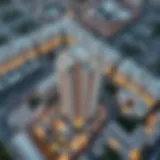Exploring Dubai's Metro Red Line: A Complete Guide
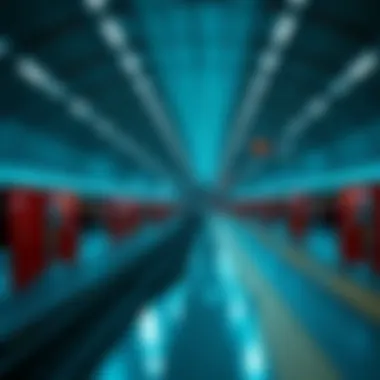

Intro
Dubai’s Metro Red Line stands as a symbol of the city’s ambition and growth, weaving through the urban landscape in a manner that reshapes the daily lives of residents and visitors alike. Since its inception, it has become an essential component of Dubai's public transport system, connecting various neighborhoods and cultural landmarks while facilitating ease of movement across the sprawling metropolis. The line not only service commuters but has also had a significant impact on real estate development, transforming the urban environment into a vibrant hub of opportunities.
This article embarks on a thorough exploration of the Metro Red Line, diving into its historical backdrop, operational efficiency, and the vital stations that dot its course. By exploring these facets, we aim to illuminate how the Metro Red Line is not just a transport system, but a catalyst for urban development and investment potential throughout Dubai. Whether you're a commuter looking for practical travel tips or an investor analyzing market trends, this guide offers valuable insights that cater to your needs.
You'll find detailed discussions around current property prices influenced by proximity to the Metro, upcoming developments that are shaping the future landscape, and practical investment strategies that can maximize your returns in this dynamic city. As the Red Line continues to expand its reach and influence, understanding its implications becomes increasingly crucial for anyone involved in Dubai’s real estate market. By the end of this guide, you will have a firm grasp on how the Metro Red Line serves as a bedrock for both accessibility and economic vitality in Dubai.
Prelims to the Metro Red Line
The Metro Red Line stands as a pivotal component of Dubai's extensive public transportation network. As Dubai continues its rapid growth and urbanization, this line serves not only as a vital transit system but also as a catalyst for economic development and urban planning. The emphasis on high-efficiency transportation is paramount in a city where real estate is booming and mobility directly impacts property values.
Understanding the nuances of the Metro Red Line is crucial, especially for stakeholders in the real estate sector—agents, investors, property managers, and potential homebuyers. All are engaged in a dynamic marketplace where accessibility can significantly influence purchasing decisions and overall satisfaction.
Overview of Dubai's Metro System
Dubai's Metro system, inaugurated in 2009, has transformed the way residents and tourists navigate the city. Operating on a driverless model, this system showcases Dubai’s commitment to innovation, integrating technology with urban mobility. The Metro comprises two lines: the Red Line and the Green Line, with the former being the backbone connecting key regions.
What sets the Metro apart is its ability to connect vital hotspots in Dubai—commercial centers, tourist sites, and residential areas. This system has evolved from a simple transport method to a significant urban planner's tool, shaping developments in proximity to various stations, especially along the Red Line.
Launch and Development Timeline
The journey of the Metro Red Line began in 2005, when construction officially kicked off as part of a broader strategy to enhance public transport in a city often dominated by cars. This project marked a significant change in how Dubai approached urban infrastructure.
- 2005: Groundbreaking for the Metro project.
- 2009: Official opening of the Red Line, stretching from Rashidiya to Nakheel Harbour and Tower.
- 2010-2014: Expansion efforts saw the addition of new stations and further development of service and technology.
- 2016 Onwards: Ongoing enhancements in frequency, safety measures, and integration with other transport systems.
As the Red Line continues to evolve, future expansions are anticipated to enhance its reach, making it increasingly relevant in the city's urban fabric—that is, connecting more areas to the central business district and embarking on further integration with bus systems and water transport.
Such milestones mark not just a timeline but underscore the proactive approach Dubai has taken towards building a sustainable urban future. By continuously investing in infrastructure, the Metro Red Line remains an essential artery within the city's growing ecosystem.
Key Features of the Metro Red Line
The Metro Red Line stands as a lifeline in Dubai’s ever-expanding urban sprawl. It symbolizes not just the city's commitment to modernisation but also its dedication to sustainable urban transportation. Understanding the key features of the Metro Red Line is critical for various stakeholders—be it commuters, real estate agents, or investors. This section discusses its specifications, technology, and safety measures, embodying the benefits of streamlined public transport in a bustling metropolitan environment.
Line Specifications and Length
The Metro Red Line is a marvel of engineering, stretching approximately 52.1 kilometers. It consists of multiple track sections, connecting 29 stations that link key areas across the city. The line operates predominantly as an above-ground railway, although a portion of it runs underground. This duality in construction maximises efficiency while minimizing disruption to the vibrant cityscape below.
The stations themselves are designed with accessibility in mind. For instance, high ceilings, spacious waiting areas, and ample signage ensure that passengers, regardless of their specific need, can navigate with ease. These specifications not only enhance the commuter experience but also become a talking point for real estate professionals who can leverage this connectivity when marketing properties.
Technology and Infrastructure
The Metro Red Line integrates cutting-edge technology to optimize its operations. From the automated train control systems to the efficient service frequency, every aspect showcases advanced urban transit solutions. The trains, which are driverless, operate on an automatic system that enhances punctuality—often exceeding 99% reliability. This is particularly essential in a city like Dubai, where time is of the essence for both commuters and tourists alike.
In terms of infrastructure, the line is constructed with sustainability in mind. Modern train sets are energy-efficient, and station designs incorporate natural light to reduce electricity consumption. These eco-friendly features resonate well with investors looking to promote sustainable living, thereby highlighting the positive impact of the Metro on real estate valuation.
Safety Measures and Efficiency
Safety is paramount on the Metro Red Line. The system employs a multi-tiered safety protocol, including surveillance cameras, emergency stations, and regular safety drills. The trains are equipped with advanced anti-collision technology, ensuring that passenger safety remains uncompromised even during peak hours.
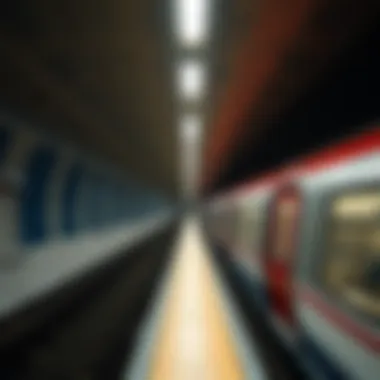

Moreover, the efficiency of the Metro contributes significantly to the reduction of traffic congestion within the city. According to studies, the Metro has prevented thousands of vehicles from hitting the roads daily, showcasing a success story in urban transport management. This attribute makes the line an attractive option for both daily commuters and investors, as it underpins the growing appeal of properties located within close proximity to stations.
"The Metro Red Line is redefining urban mobility in Dubai, paving the way for an eco-friendly and efficient transport network."
As we can see, the various specifications, cutting-edge technology, and robust safety measures of the Metro Red Line play a crucial role in enhancing the overall public transport system in Dubai, positively influencing urban planning and property investments.
Major Stations along the Metro Red Line
The Metro Red Line in Dubai is more than just a public transport route; it serves as a lifeline connecting various aspects of this rapidly growing metropolis. This section underscores the major stations along the line, highlighting their significance for commuters, tourists, and businesses alike. Each station plays a pivotal role in enhancing accessibility and promoting economic activities in their respective areas. Thus, understanding these stations can make a notable difference for real estate agents, investors, and homebuyers who are keen on leveraging the dynamics of Dubai’s urban environment.
Union Station: A Central Hub
Union Station stands as the beating heart of Dubai's Metro system. Serving as a crucial interchange, it connects the Red Line with the Green Line, effectively doubling the stations' impact on accessibility. Located in the bustling Deira district, it caters not only to locals but also to tourists navigating through the city. The station is a short walk away from key commercial spots, such as the Al Ghurair Centre and the Dubai Fish Market.
This station’s significance can't be overstated; it’s a staging ground for commuters making their way to work in various parts of the city or catching connections to other lines. Furthermore, Union Station is instrumental in handling high traffic loads, especially during peak hours, making it an essential node in Dubai’s transportation grid.
Burj Khalifa/Dubai Mall Station: Tourism and Commerce
Next, we have the Burj Khalifa/Dubai Mall Station, where tourism meets commerce in a spectacular way. Situated near the tallest building in the world and the expansive Dubai Mall, this station is designed for people on the go. It showcases how transport infrastructure can directly spur economic activity.
Visitors arrive here to experience luxury shopping, fine dining, and a glimpse of the dazzling fountains. For real estate stakeholders, the proximity of this station to premium properties makes it alluring for investments. There’s a booming demand for accommodation and retail spaces in this vicinity, influenced largely by the daily foot traffic from the station.
Dubai Marina Station: Connectivity to Leisure Areas
Dubai Marina Station epitomizes leisure connectivity in a city famed for its opulence. Nestled adjacent to the dynamic Dubai Marina and Jumeirah Beach, it draws in crowds seeking entertainment and relaxation. The station offers easy access to some of the city’s most popular attractions, including Marina Walk and the Yas Island theme park.
For the investors, understanding the interplay between transport access and local amenities is crucial. The proximity to the Marina presents lucrative opportunities for residential properties, especially for those aiming to rent to tourists or young professionals. Local businesses, including cafes and boutiques, flourish due to the consistent influx of visitors.
Airport Terminal Stations: Accessibility for Travelers
Lastly, it’s impossible to overlook the significance of the Airport Terminal Stations on the Metro Red Line. Serving both Terminals 1 and 3 of the Dubai International Airport, they stand as gateways for international travelers. The ease of getting from the airport to the Metro line simplifies travel for tourists, expatriates, and business people.
This level of accessibility boosts property values in surrounding areas. The demand for hotels, short-stay apartments, and commercial venues catering to travelers increases substantially. For real estate agents, it's wise to spotlight properties near these terminals, as they hold great appeal for buyers and renters alike.
"The Metro Red Line is not just a transportation mode; it’s a facilitator of business and tourism, knitting the fabric of Dubai’s urban landscape together."
Economic Impact of the Metro Red Line
The Metro Red Line in Dubai is not just a mere transport route; it acts as a pivotal axis for economic growth and development. Its influence permeates through various sectors, primarily real estate and commerce, shaping the landscape of opportunities in this vibrant city. Understanding the economic impact of the Metro Red Line helps unravel how this infrastructure project has bolstered property values, created business avenues, and fostered urban evolution.
Influence on Property Development
One of the most notable effects of the Metro Red Line is its dramatic shift in property development trends in Dubai. The stations serve as beacons for real estate investments, guiding both local and international buyers toward properties with close proximity to public transport. For instance, areas surrounding the Union Station have witnessed significant spikes in demand. Naturally, investors are drawn to properties that promise easy access to commutes and lifestyle amenities.
When a new station opens up, it often signals a surge in property values. Take the case of the Burj Khalifa/Dubai Mall Station; it has effectively transformed the surrounding precinct into a hotspot for hotels, shopping complexes, and luxury apartments. This spike in interest is driven by potential occupants yearning for convenient transit options to work and leisure.
- Key Benefits of Metro-Linked Developments:
- Increased Property Values: Changes in property values are not only beneficial for sellers but also enhance the viability of renting in these areas.
- Attracting Diverse Tenants: The convenience factor appeals to a broader demographic, including expatriates and professionals who prioritize accessibility.
- Sustainable Growth: Over time, local businesses prosper as more people commute through these stations, encouraging long-term investments and sustainable development.
The ripple effect of enhanced accessibility creates a symbiotic relationship between transportation and real estate. In Dubai, where growth is rapid, the Metro Red Line has played a critical role in steering the direction of future developments.
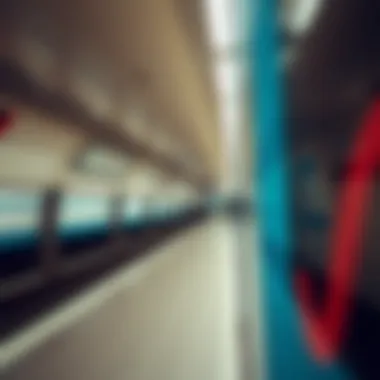

Enhancing Commercial Opportunities
The Metro Red Line has opened a cornucopia of commercial possibilities. With every station serving as a prime access point, businesses are lured to set up shop where foot traffic is considerable. Vital sectors such as retail and hospitality have capitalized on this increased patronage, leading to a flourishing entrepreneurial environment.
Businesses situated near key stations like the Dubai Marina Station benefit from high visibility and easy customer access. New ventures in the area range from boutique shops to bustling cafes. Consider the cafes lining the paths around the Marina; they experience heavy foot traffic not simply from locals but also international tourists drawn to the allure of Dubai.
Moreover, the integration of the Red Line with other forms of transport, such as buses and water taxis, reinforces commercial activity. Users often combine journeys, stop for meals, or engage in shopping, which augments business revenue. Access to transit hubs acts as a fertile ground for:
- Job Creation: New businesses tend to create jobs, addressing local employment needs.
- Increased Sales: With regular commuters and tourists, established businesses see a significant bump in sales.
- Networking Opportunities: Business events or pop-up markets proliferate in these areas, connecting entrepreneurs and consumers.
Consequently, the economic influence of the Metro Red Line creates a robust cycle of opportunity—one that neatly ties transportation, real estate, and commerce into a cohesive narrative of growth.
It's more than just a ride; it’s a pathway to prosperity that resonates throughout Dubai's economic framework.
In summary, the Metro Red Line functions as a catalyst, accelerating property and commercial developments. Its impact on the economy is profound, fostering a more interconnected and commercially viable environment that caters not just to residents but also investors and tourists alike.
Metro Red Line and Urban Planning
The Metro Red Line in Dubai serves as a pivotal aspect of the city's urban planning framework. Its creation was not just a step towards modernizing public transport, but also a cornerstone in enhancing the strategic growth of Dubai as a global city. This section dives into the intricate relationship between the Metro Red Line and urban planning, shedding light on its crucial contributions and implications.
Role in Sustainable Urban Development
Sustainable urban development encompasses efforts to create infrastructure that respects the environment while meeting the needs of the present without compromising future generations. The Metro Red Line plays a significant role in this concept. Firstly, it encourages public transportation adoption over personal vehicle use, effectively reducing traffic congestion and carbon emissions. As iron birds darting through the sky of concrete, trains become a cleaner option for every commuting soul.
Moreover, the line's design incorporates green spaces and surrounding parks, improving the quality of life for Dubai's residents. For instance, stations like Burj Khalifa/Dubai Mall not only serve transportation needs but also connect people to recreational areas where families can unwind amid the hustle of city life.
Another interesting angle to consider is how the Metro's route influences real estate development. Properties near metro stations often see increased demand and higher values, driving developers to focus on mixed-use facilities that combine residential, commercial, and leisure spaces. This is a win-win; residents gain easy access to the metro while enjoying a well-rounded lifestyle.
In this light, the Red Line does not solely function as a transit route; it actively shapes how Dubai builds its future.
Integration with Other Transportation Systems
A well-connected city can significantly boost its economic resilience, and the Metro Red Line stands out in this regard through its integration with various transportation systems. This synergy encourages seamless travel within the metropolitan area, which is vital for daily commuters, tourists, and businesses alike.
The Metro Red Line links with the Dubai Tram, for instance. Passengers can effortlessly switch between these modes of transport to reach their destinations without hassle. Such integrated networks reflect strategic planning aimed at maximizing convenience. It’s like connecting puzzle pieces that, when put together, form a clearer image of a fully functional urban landscape.
Another essential aspect is the line's connectivity with several bus services. With stops at major entry points, it facilitates easy transfers, making public transport not merely an option but an integral part of daily routines. Additionally, this system decreases reliance on private cars, thereby alleviating pressure on parking spaces in busy areas.
To contextualize this, consider this situation: a family visiting the Dubai Marina can hop on the metro, switch to the tram for a scenic ride, and exit near their desired destination, highlighting how intermodal connectivity can cater to various travel styles and preferences.
As we peer into the future of Dubai’s urban landscape, one cannot underestimate how crucial the Metro Red Line is for shaping city dwellers' experiences and enhancing the city’s overall transport efficiency. By embodying sustainable practices and fostering an integrated transport network, it lays the foundation for a more connected and dynamic urban living environment.
The Metro Red Line not only redefines movement across Dubai but also carves out pathways for enriching community life.
User Experience on the Metro Red Line
A seamless user experience is pivotal for any public transportation system. This is especially true for the Metro Red Line in Dubai, where the varying needs of commuters converge. The design and operations of this line are deeply intertwined with enhancing daily travel for users, whether they are locals, tourists, or business professionals. Understanding the components that contribute to user satisfaction can help reveal the Metro Red Line's significance in Dubai’s wider transportation landscape.
Ticketing System and Pricing
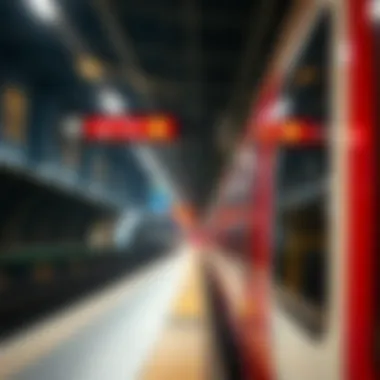

Navigating the ticketing system on the Metro Red Line can initially appear complex, yet it is designed for user convenience. There are two key options available: the Nol Card and single journey tickets. The Nol Card offers the benefit of cashless transactions, simplifying the entry and exit process at stations. These cards are easily rechargeable at kiosks or vending machines located throughout the metro system.
Pricing is tiered based on the distance traveled, making it economical for frequent riders. For instance, traveling from Union Station to Dubai Marina might cost a user a specific amount, while longer journeys, say to the Airport Terminal Stations, could bear a slightly higher fare. Often, commuters find themselves paying between 3 to 8 dirhams, which is relatively affordable compared to taxi fares.
"Riding the metro is not just about getting from point A to B; it’s about enjoying the journey without burning a hole in your pocket."
Onboard Amenities and Services
Comfort and convenience aboard the Metro Red Line serve as essential attractions for users. Trains are equipped with spacious seating and expansive windows, offering passengers a view of the stunning Dubai skyline as they travel. The interiors are air-conditioned, providing a respite from the region's heat, and although the trains can get crowded during peak hours, there’s usually a seat available at non-peak times.
Additionally, on-board announcements are clearly communicated in both Arabic and English, ensuring that all passengers are well-informed about upcoming stations and connections. Multi-language displays also help non-native speakers navigate the system with ease. Free Wi-Fi service is provided in many stations, helping riders stay connected during their transit, which makes a commute a less daunting task.
Accessibility Features for All Riders
The Metro Red Line prides itself on inclusivity. Recognizing that mobility can be a challenge for some, the line incorporates various accessibility features. Elevators are available at nearly all stations, providing access to platforms for those with physical disabilities or those traveling with strollers.
Visual aids and tactile guidance help visually impaired individuals navigate their way. Priority seating is designated for the elderly and physically challenged passengers, further showing consideration for the diverse user base. There’s also information readily available for those who need assistance; staff members are trained to help anyone struggling in navigating the system.
Challenges and Future Prospects
As Dubai’s Metro Red Line continues to be a pivotal part of the city’s transport landscape, it faces its own unique hurdles and opportunities. Understanding these challenges, along with future expansion plans, is critical for various stakeholders, including investors, property managers, and residents. Identifying limitations now can pave the way for thoughtful enhancements that align with the dynamic urban fabric of Dubai. Raising awareness about these issues aids in fostering informed decisions and strategies for all involved.
Current Limitations and Issues
Despite the Metro Red Line’s success in modernizing urban transportation, it isn't without flaws. Here are a few pressing concerns:
- Capacity Constraints: During peak hours, the trains often run at full capacity, leaving some passengers waiting for the next one. This situation underscores the pressing need for improved frequency and possibly longer trains.
- Maintenance Challenges: Keeping the infrastructure up to par given Dubai's rapid growth can be daunting. Older segments might require more frequent maintenance, leading to service interruptions.
- Integration with Other Transport Systems: While the Red Line connects well within itself, integrating with buses, water taxis, and other transport modes isn't seamless. Passengers sometimes find it confusing to switch between modes.
The shortcomings highlighted here can hinder user satisfaction and ultimately could impact property values near stations. For property investors, this means keeping a close eye on usage patterns and commuter experiences.
Future Expansion Plans
To address these limitations and keep pace with Dubai's growth, strategic expansion plans are on the horizon for the Metro Red Line. Some key aspects include:
- New Stations: The Dubai Roads and Transport Authority (RTA) has announced plans for additional stations that will extend the reach of the line, connecting it with emerging neighborhoods and commercial centers, thereby increasing access for both residents and businesses.
- Increased Train Frequency: Plans to increase the frequency of trains are underway, helping to alleviate crowded conditions during rush hour. Improved scheduling could mean trains running every two to three minutes.
- Enhanced System Features: Implementation of smarter technologies, like automated real-time scheduling and user-friendly apps for route planning, aim to improve overall traveler experiences.
"The expansion of the Metro Red Line is not just about adding more tracks; it is about enhancing the quality of life for Dubai's residents and boosting an already thriving economy."
With these expansion plans, not only will the Metro Red Line improve its operational efficiency, but it also could play a crucial role in sustaining the vibrant real estate market. Investors may find that properties near new stations stand to benefit significantly, given the increased connectivity they will offer.
Navigating these challenges and prospects is vital for investors, giving them insight into the underlying dynamics that will influence the future of Dubai’s urban landscape. Understanding how these transformations can drive property values and connectivity is key to making informed investments.
Finale
In summing up the extensive impact of the Metro Red Line in Dubai, it becomes clear that this transit system is not just a mode of transportation; it's a driving force behind the city’s growth and development. Residents, investors, and visitors alike benefit from its efficient connectivity between key districts, easing daily commutes and enhancing overall quality of life.
The Red Line plays a vital role in shaping Dubai's urban landscape and economic vitality in several ways:
- Enhanced Accessibility: The Metro Red Line opens up various neighborhoods, making it easier for people to travel across the city without the hassle of traffic congestion. Commuters can save time and costs, which is particularly appealing to those who work in bustling commercial areas like the Dubai International Financial Centre.
- Property Value Influencer: With many key stations located near high-demand real estate areas, the Metro Red Line directly affects property values. Real estate agents and investors should note that proximity to a metro station often translates to higher rental prices and increased demand.
- Encouraging Sustainable Living: The infrastructure of the Metro directly aligns with Dubai’s goal of promoting public transport, reducing dependence on personal vehicles, and minimizing the city's carbon footprint. It presents an appealing option particularly for environmentally-conscious homebuyers.
Furthermore, the future of the Red Line promises even greater connectivity and efficiency. With plans for extensions and upgrades, it is strategically designed to keep pace with Dubai's growth.
In closing, the Metro Red Line has become synonymous with modern living in Dubai. It represents not just a transit solution but also a catalyst for urban revitalization, real estate development, and the promotion of a more sustainable, connected city. As potential investors and residents consider their options, understanding the importance of this transportation network is essential to making informed decisions in the dynamic landscape of Dubai's real estate market.
"The Metro is more than just a train; it’s the lifeblood flowing through Dubai, connecting its past, present, and future."
For further insights into Dubai's fantastic transport solutions and more about its vibrant real estate market, you can explore resources like Wikipedia on Dubai Metro and Britannica for additional historical and cultural context.


